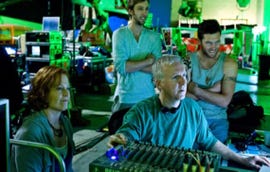‘Avatar’ Is Coming Back to Theaters, so Here’s Our Original Review
Sci-fi epic Avatar premiered on Dec. 10, 2009, and immediately shattered box office records to became the highest-grossing film of all time (until Avengers: Endgame came along 10 years later). It was a groundbreaking, Oscar-winning, 3D visual effects spectacular that ushered in the age of modern CGI blockbusters — and yet, overshadowed by Marvel, the actual story quickly slipped from the minds of most viewers.
But the long-promised sequel is finally arriving, as Avatar 2: The Way of Water is now scheduled for release this coming December. Before that, the original film will be re-released in theaters in September, or you can stream it on Disney Plus. To refresh your memory, this is the CNET review of the original, first published in December 2009.
We’ll say this for James Cameron, he doesn’t do things by halves. Twelve years after his last film and boasting the biggest budget, glossiest CGI and most intense 3D effects ever committed to the silver screen, Avatar has finally arrived to change cinema forever. At least, that’s the hype — CNET donned the 3D glasses of truth to see how the film shapes up.
Avatar follows wheelchair-bound US Marine Jake Sully (Sam Worthington) as he arrives on the lush but dangerous world of Pandora. He’s there to control an avatar, a hybrid of human DNA and the DNA of Pandora’s native humanoids, the Na’vi. Jake is taught the ways of nature by Na’vi princess Neytiri (Zoe Soldana), all the while torn between scientist Dr. Grace Augustine (Sigourney Weaver) and gung-ho military man Colonel Quaritch (Stephen Lang). As the human mining operation tears down the home of the Na’vi, Jake has to decide whose side he’s on…
Yeah. We know. We sat down to watch Avatar determined not to bash the story, because it’s something of a cliché that effects-heavy films are all style and no storytelling. But Avatar is, sadly, every bit as derivative as it sounds. It’s Aliens meets Pocahontas, Dances With Wolves meets Return of the Jedi, with 10-foot blue-skinned aliens instead of Indians and Ewoks.
The cast is wall-to-wall stereotypes: lantern-jawed marines and corporate tools on one side, noble princesses and proud warriors on the other, with hackneyed ancient prophecies, ham-fisted eco themes and Lion King spirituality thrown in for good measure. It’s even got Wes “Last of the Mohicans” Studi in it, in case you were in any doubt that the Na’vi are an allegory for Native Americans and nature and looking after the planet and respecting other cultures, an’ that.
Cameron even filches from himself to populate the cast of stereotypes, with Michelle Rodriguez’s ballsy Latina and Giovanni Ribisi’s sleazy salaryman channeling Aliens’ Vasquez and Burke.

James Cameron shows off cutting edge filmmaking technology to Sigourney Weaver and Sam Worthington.
Still, the Na’vi are impressively expressive for blue-skinned aliens. Motion capture wasn’t enough for Cameron, who developed performance capture, the actors wearing tiny webcams all over their heads to capture their expressions in exacting detail. The detail particularly shows in the face of Zoe Soldana’s Neytiri.
It’s interesting that the film shows us both the human and CGI faces of several of the cast. Worthington’s good looks lead to a generic avatar face, but there’s a genuine frisson the first time we see a CGI face that looks just like Sigourney Weaver, only blue and with funny ears.
The problem with the splitting of human and Na’vi worlds is that the story keeps “real” and CGI separate for most of the film. There’s a sharp contrast between the subtle 3D and nifty holographic effects of the human base, all real sets and real actors, and the lush computerized jungle, all dizzying camera swoops and neon-colored critters. The CGI creations lack weight: We’ll take the clunky but utterly solid power-loader from Aliens over Avatar’s technically accomplished but implausibly graceful mecha war suits any day.
Cameron pioneered a number of new shooting techniques for Avatar, including a “virtual camera” system. When pointed at actors in performance-capture suits standing against empty backdrops, the virtual camera allowed Cameron to see what had previously existed only in his imagination: great big blue aliens in a computer-generated environment. He even reinvented 3D cameras — testing them in a World War II fighter plane, of all things. The effort was worth it, and it’s all there on the screen.

The CGI sequences, while spectacular, look disjointed from the “real” bits.
Cameron manages to be relatively restrained, however. From the Wachowski brothers’ Matrix sequels and George Lucas’ Star Wars prequels to Michael Bay’s Transformers films, heavily CGI-driven movies have packed the screen with action to the point that they can be hard to follow. Cameron goes easy on the chaos, with more vertiginous tree-running and flying animals than battle scenes. The scraps, when they do come, are pretty flat. They’re just too one-sided — bows and arrows against gunships — and lack the small moments of pathos that make Titanic’s spectacular destruction so affecting.
There are a few attempts to anchor the CGI in reality. A soldier’s hat flies off as a spaceship passes by; there’s the odd deliberately botched zoom or focus pull. But most of the time, the CGI and real elements sit uncomfortably next to each other. It’s a shame, because when Na’vi and human do come together it looks ace — in a tender moment between Sully and Neytiri, or an all-too-brief dustup in which arrows fired by 10-foot aliens thrillingly shift in our perspective to become spear-size projectiles punching holes in puny humans.
Despite the clunky voiceover and unforgivable use of “unobtainium”
as a plot device, Avatar is engaging throughout, and the two and a half hour running time never drags. The CGI is still too glossy to really convince, but the 3D is eyepopping from stunning opening shot right to the end.
